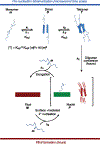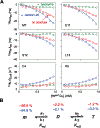Effects of Macromolecular Cosolutes on the Kinetics of Huntingtin Aggregation Monitored by NMR Spectroscopy
- PMID: 38857530
- PMCID: PMC11345868
- DOI: 10.1021/acs.jpclett.4c01410
Effects of Macromolecular Cosolutes on the Kinetics of Huntingtin Aggregation Monitored by NMR Spectroscopy
Abstract
The effects of two macromolecular cosolutes, specifically the polysaccharide dextran-20 and the protein lysozyme, on the aggregation kinetics of a pathogenic huntingtin exon-1 protein (hhtex1) with a 35 polyglutamine repeat, httex1Q35, are described. A unified kinetic model that establishes a direct connection between reversible tetramerization occurring on the microsecond time scale and irreversible fibril formation on a time scale of hours/days forms the basis for quantitative analysis of httex1Q35 aggregation, monitored by measuring cross-peak intensities in a series of 2D 1H-15N NMR correlation spectra acquired during the course of aggregation. The primary effects of the two cosolutes are associated with shifts in the prenucleation tetramerization equilibrium resulting in substantial changes in concentration of "preformed" httex1Q35 tetramers. Similar effects of the two cosolutes on the tetramerization equilibrium observed for a shorter, nonaggregating huntingtin variant with a 7-glutamine repeat, httex1Q7, lend confidence to the conclusions drawn from the fits to the httex1Q35 aggregation kinetics.
Conflict of interest statement
Notes
The authors declare no competing financial interest.
Figures




Similar articles
-
Nucleation of Huntingtin Aggregation Proceeds via Conformational Conversion of Pre-Formed, Sparsely-Populated Tetramers.Adv Sci (Weinh). 2024 Jun;11(24):e2309217. doi: 10.1002/advs.202309217. Epub 2024 Mar 12. Adv Sci (Weinh). 2024. PMID: 38476051 Free PMC article.
-
Quantitative NMR analysis of the kinetics of prenucleation oligomerization and aggregation of pathogenic huntingtin exon-1 protein.Proc Natl Acad Sci U S A. 2022 Jul 19;119(29):e2207690119. doi: 10.1073/pnas.2207690119. Epub 2022 Jul 12. Proc Natl Acad Sci U S A. 2022. PMID: 35858329 Free PMC article.
-
Quantitative Exchange NMR-Based Analysis of Huntingtin-SH3 Interactions Suggests an Allosteric Mechanism of Inhibition of Huntingtin Aggregation.J Am Chem Soc. 2021 Jun 30;143(25):9672-9681. doi: 10.1021/jacs.1c04786. Epub 2021 Jun 17. J Am Chem Soc. 2021. PMID: 34137596 Free PMC article.
-
Solid-state nuclear magnetic resonance in the structural study of polyglutamine aggregation.Biochem Soc Trans. 2024 Apr 24;52(2):719-731. doi: 10.1042/BST20230731. Biochem Soc Trans. 2024. PMID: 38563485 Free PMC article. Review.
-
Regulation of the structural dynamics, aggregation, and pathogenicity of polyQ-expanded Huntingtin by osmolytes.Prog Mol Biol Transl Sci. 2025;211:113-143. doi: 10.1016/bs.pmbts.2024.08.005. Epub 2024 Sep 7. Prog Mol Biol Transl Sci. 2025. PMID: 39947746 Review.
Cited by
-
Pathogenic Proteins Through the Lens of NMR Spectroscopy: Structural and Functional Insights into Disease.Cell Biochem Biophys. 2025 Aug 13. doi: 10.1007/s12013-025-01869-1. Online ahead of print. Cell Biochem Biophys. 2025. PMID: 40801977 Review. No abstract available.
-
Crowding-induced stabilization and destabilization in a single protein.Protein Sci. 2025 May;34(5):e70126. doi: 10.1002/pro.70126. Protein Sci. 2025. PMID: 40260960
-
Modeling Protein Aggregation Kinetics from NMR Data.J Mol Biol. 2025 Jun 9:169269. doi: 10.1016/j.jmb.2025.169269. Online ahead of print. J Mol Biol. 2025. PMID: 40499748 Review.
References
-
- Zuccato C; Valenza M; Cattaneo E Molecular Mechanisms and Potential Therapeutical Targetsin in Huntington’s Disease. Physiol. Rev. 2010, 90, 905–981. - PubMed
-
- Wetzel R Exploding the Repeat Length Paradigm While Exploring Amyloid Toxicity in Huntington’s Disease. Acc. Chem. Res. 2020, 53, 2347–2357. - PubMed
-
- Bates GP; Dorsey R; Gusella JF; Hayden MR; Kay C; Leavitt BR; Nance M; Ross CA; Scahill RI; Wetzel R; et al. Huntington Disease. Nat. Rev. Dis. Primers 2015, 1, 15005. - PubMed
-
- Andresen JM; Gayan J; Djousse L; Roberts S; Brocklebank D; Cherny SS; Cardon LR; Gusella JF; MacDonald ME; Myers RH; et al. The Relationship between CAG Repeat Length and Age of Onset Differs for Huntington’s Disease Patients with Juvenile Onset or Adult Onset. Ann. Hum. Genet. 2007, 71, 295–301. - PubMed
MeSH terms
Substances
Grants and funding
LinkOut - more resources
Full Text Sources

